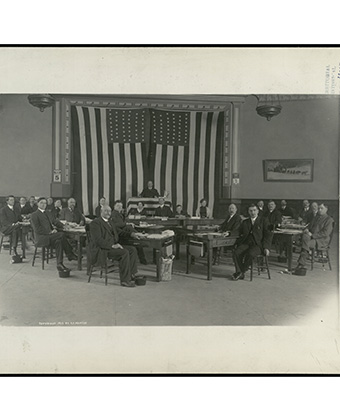Last updated: July 29, 2019
Person
First Territorial Legislature of Alaska

Courtesy of the Alaska State Library, Henry Roden Photo Collection. Photo by A. C. Mercer, P461-26.
On March 30, 1867 the United States purchased Alaska from what was then the Russian Empire. Forty-five years later, in 1912, the US Congress voted to create the Territory of Alaska and establish the Alaska Territorial Legislature. The first session of the legislature met from March 3 to May 1, 1913 in the Juneau Elks Lodge.[1] Their first act of the all-male Territorial Legislature was to grant Alaska women the right to vote.
House Bill No. 2, An Act to Extend the Elective Franchise to Women in the Territory of Alaska, reads:
Be it enacted by the legislature of the Territory of Alaska: That in all elections which are now, or may be hereafter authorized by law in the Territory of Alaska, or any sub-division or municipality thereof, the elective franchise is hereby extended to such women as have the qualifications of citizenship required of male electors.
The bill passed the House on March 14, 1913; passed the Senate on March 18, 1913; and was signed into law by the Governor of Alaska Territory, Walter Eli Clark, on March 21, 1913.[2]
Excluded from voting were Alaska Natives, who were denied the vote and participation in elections by the Act that established the Alaska Territory. Activists from the Alaska Native Brotherhood and Sisterhood advocated for Native suffrage rights. In 1915, the Alaska Territorial Legislature recognized the right of Indigenous people to vote on the condition they gave up tribal customs and traditions.
In 1924, the Indian Citizenship Act was signed into law, granting US citizenship to all Native Americans -- including those in Alaska, and regardless of whether they gave up their culture. But states could limit who had access to the vote, and many states -- including Alaska -- excluded certain groups from the ballot. In Alaska, as in many of the Southern US states, the Territorial Legislature passed a literacy requirement for all new voters. While it seems as though the law was only selectively enforced, it remained in effect, and became part of the Alaska State Constitution.
Alaska did not become a US state until January 3, 1959 and so was unable to vote to ratify the 19th Amendment before it became law in 1920.
Notes:
[1] First Territorial Legislature members were:
Senate: Elwood Bruner, Conrad Freeding, Thomas McGann, B.F. Millard, L.V. Ray (Senate President), Henry Roden, Dan Sutherland, J.M. Tanner, and Herman Tripp.
House: Frank Aldrich, Frank Boyle, William Burns, Earnest Collins (Speaker of the House), Daniel Driscoll, Thomas Gaffney, Robert Gray, Charles Ingersoll, H.B. Ingram, Charles D. Jones, Milo Kelly, James C. Kennedy, J.J. Mullaly, Arthur Shoup, William Stubbins, and N.J. Svindseth.
[2] Clark lived in the Alaska Governor's Mansion in Juneau; he was its first occupant when it was built in 1912. It was listed on the National Register of Historic Places on November 7, 1976. It is within the Juneau Downtown Historic District, listed on the National Register of Historic Places on June 17, 1994.
References:
Alaska State Legislature. 100 Years of Alaska’s Legislature: "Territorial Legislature Organizes"
Alaska Digital Archives, House Bill No. 2
US National Library of Medicine; Native Voices: 1912: Territory of Alaska Gains Congressional Delegate
Kitka, Julie. “Protecting Alaska Natives’ Right to Vote -- No Matter What Language they Speak -- Is Critical.” Anchorage Daily News, June 11, 2014 (updated June 29. 2016).

